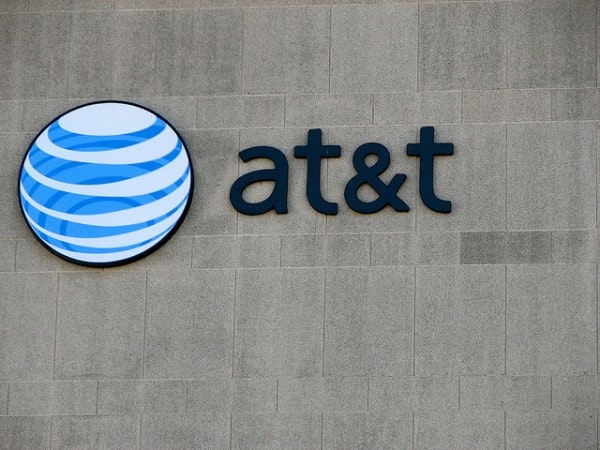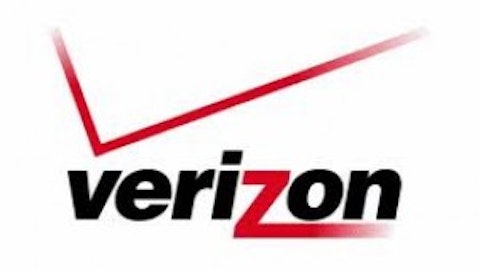According to the Cellular Telecommunications & Internet Association (CTIA) there are approximately 180 wireless service providers in the United States. That’s a whole lot of choice for consumers, but not so much for investors. Of those 180 providers, the largest four control more than 90% of the market, 294.2 million out of the 321.7 million subscriptions reported by the CTIA. This article will focus on three out of those four, as the fourth, T-Mobile, is owned by German based Deutsche Telekom and therefore cannot be directly invested in without investing in the company as a whole.

The subscriber leader
According to its 2012 Q4 report, AT&T Inc. (NYSE:T) is the largest phone company in terms of subscribers, which totaled 107 million at year end. It is also the largest wireless provider in terms of market capitalization with $201 billion. Trailing twelve month price-earnings is not a very good metric to use when analyzing these companies, but for information purposes it is the best of the companies in this article at 29.3. But that’s enough of a technical analysis, now on to the real issues.
Last year AT&T Inc. (NYSE:T) had revenue of $127.4 billion and earnings per share of $1.25. The company purchased 6%, or 371 million, of its outstanding shares in 2012, enabling it to save $700 million in annualized dividend payments. Speaking of dividends, the company is currently yielding 4.92% and has been increasing dividends steadily for 29 consecutive years. Revenue generated by the company’s wireless segment is growing quickly, especially pertaining to data revenue, which increased 14.7% over 2011 to $6.8 billion. This growth can probably be attributed to AT&T’s blazing fast LTE, which was ranked by a Root Metrics test in the second half of 2012 as the fastest pure LTE with an average download speed of 18.6 Megabits per second. The company has a very strong 2013 outlook with expected consolidated revenue growth of 2%. They also plan to authorize another share repurchase program which should help the stock price even more.

Most of AT&T’s revenue comes from its wireless segment
The geographic king
Verizon Communications Inc. (NYSE:VZ) states in its 2012 Q4 report that its 4G LTE network is available in 476 markets to over 273 million people, or 89% of the U.S. Population, making it the largest 4G LTE network in the country. Over 50% of data use by Verizon subscribers is on its 4G LTE network. This is due to the fact that in the fourth quarter alone, Verizon activated 9.8 million smartphones, accounting for 87% of postpaid phone activations in that time frame. Again, although price-earnings is not a very good metric to use with these companies, for information purposes, Verizon’s is currently 155.06.
The company reported earnings per share for the year of $0.31, down quite a bit from the previous year due to struggles with pensions in the fourth quarter that affected AT&T Inc. (NYSE:T)’s earnings as well. Aside from pension problems, Verizon Communications Inc. (NYSE:VZ) is growing faster than it has in the past four years, adding 5 million new postpaid customers in 2012, up 5.9% year over year. Of these 5 million new postpaid customers, 2.1 million were added in the fourth quarter, up 53.7% from the fourth quarter of 2011. Verizon is currently yielding 4.31% in dividends and does not have a share repurchase program at this time.

Verizon is clearly the leader in terms of coverage area
The underdog
In 2005, Sprint Nextel Corporation (NYSE:S) purchased Nextel for $36 billion, a mistake that would cause the nation’s third largest wireless service provider to take a $29.7 billion goodwill write-down in 2008. After the write-down, the company began a turnaround which includes getting rid of the Nextel brand. There are three phases to this transformation: Recovery, Investment, and Margin Expansion. In the Recovery phase (2008-2011), Sprint improved its brand image, reduced costs, added customers, and saved money for the Investment stage.
During this second part of its transformation (2012-2013), Sprint Nextel Corporation (NYSE:S) is carrying out a project called Network Vision, which will upgrade all of its existing networks, and give it speeds and coverage on par with Verizon Communications Inc. (NYSE:VZ) and AT&T Inc. (NYSE:T). According to its 2012 Q4 investor presentation, there are more than 8,000 sites on air with 19,500 either ready for construction or already under construction. This 19,500 figure represents roughly half of the sites to be upgraded. There are currently 58 cities with Sprint 4G LTE and there are 170 more planning to launch within the next couple of months. Customer counts on the Sprint platform have increased 45% from 36.9 million in 2008 to 53.5 million at year-end 2012.
In the process of shutting down the Nextel platform, Sprint Nextel Corporation (NYSE:S) is attempting to recapture the customers it loses by adding them to the Sprint network. In 2011 Sprint’s postpaid recapture rate was only 30% but in 2012 Sprint managed to recapture 55% of customers leaving the Nextel platform, adding a total of 333,000 Nextel postpaid customers to the Sprint platform. Nextel is scheduled to shut down by the end of June 2013.
Sprint Nextel Corporation (NYSE:S) also added the iPhone to its collection of phones at the end of 2011, making the company better able to compete with AT&T and Verizon. Sprint reported selling 6.6 million iPhones in 2012, 40% of which were to new customers. The biggest piece of news for Sprint right now is that it has agreed to be purchased by Japanese telecommunication giant SoftBank. To find out what this transaction will do to the share price, you can read this Forbes article, but for the purposes of this article, all you need to know is that this deal would give Sprint an extra $8 billion in capital to help with Network Vision. Sprint’s CEO expects the company to begin being profitable in fiscal year 2014.

Sprint’s transformation plan estimates profitability will begin in 2014
The takeaway
After briefly analyzing each of these three companies, we see that each one has strengths and weaknesses in various areas. AT&T Inc. (NYSE:T) will need to keep expanding its LTE availability to compete with Verizon, while Verizon Communications Inc. (NYSE:VZ) will have to increase its speed to compete with AT&T. Sprint needs an all-around remodel to bring it into the realm of the other two giants. Two different types of investments stand out to me here. I see AT&T and Verizon as established leaders in their industry, paying great dividends and allowing investors to park their money and not look at it until they retire. I personally prefer AT&T as its dividend yield is slightly higher and it looks better poised to grow.
On the other hand is Sprint Nextel Corporation (NYSE:S), the underdog, trying its best to catch up to the other two. Sprint is definitely headed in the right direction, and the stock price more than doubled in 2012. This buyout from SoftBank can make things even better at Sprint, or it can try to take Sprint in a direction the market doesn’t want it to go. This is definitely a growth stock. Any investor who puts his money in Sprint should understand that he is risking the money he has in hopes of getting a great return.
Growth or Dividend? Which style of investment will you choose?
The article Which Big Wireless Company to Buy Right Now? originally appeared on Fool.com and is written by Nathaniel Munson.
Copyright © 1995 – 2013 The Motley Fool, LLC. All rights reserved. The Motley Fool has a disclosure policy.
